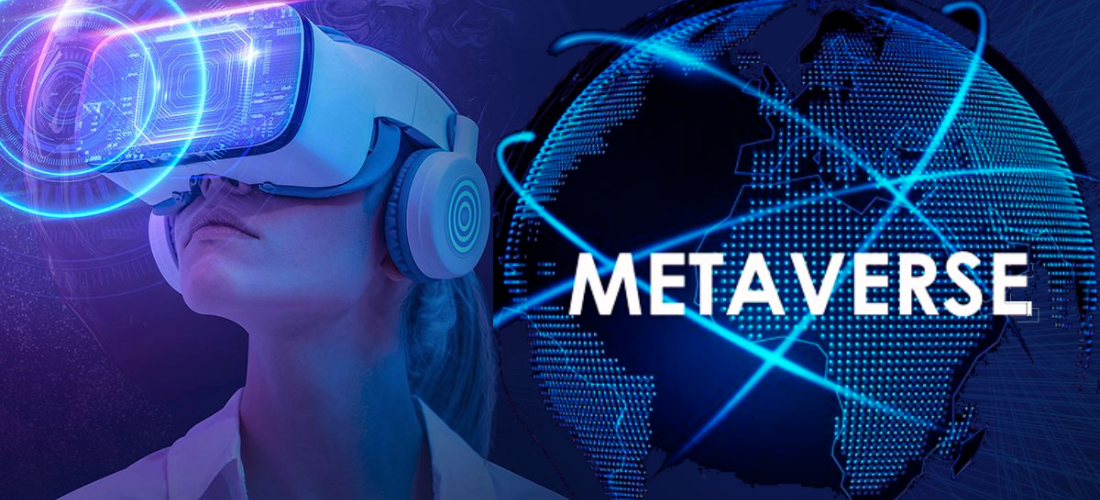What is the Metaverse? – All You Need to Know

The metaverse is often regarded as the subsequent stage in the development of the internet. Find out what kinds of businesses are getting involved in the activity.
Imagine for a moment that there is a virtual world in which individuals may live, work, shop, and engage in conversation with one another, all while sitting on their sofa in the real world. This location is referred to as the metaverse.
The word “Metaverse” did not reach common use until October 2021, when Facebook announced that it would change its name to Meta. At that time, the business declared its intentions to invest a total of $10 billion over the course of the next year in the development of technologies that would help it realize its vision of the metaverse.
The metaverse is often regarded as the next stage in the development of the internet. It will manifest itself in a variety of settings, including gaming, online communities, and business meetings in which participants share a digital representation of themselves, also known as an avatar.
What is the Metaverse?
Metaverses aren’t new. Snow Crash was described in 1992. The idea inspired other online communities, including 2003’s Second Life.
In the metaverse, avatars represent individuals, communicate, and establish communities. Digital money buys clothing, weapons, and other commodities in the metaverse. Virtual reality headsets and controllers allow users to explore the metaverse without a purpose.
Snow Crash portrayed the metaverse as a gloomy future. Metaverse is a virtual reality-based internet invented by Neal Stephenson. In Stephenson’s metaverse, a user’s avatar’s complexity indicates technical proficiency. Access to restricted areas was a predecessor to paywalls and registration requirements on certain websites.
Ready Player One by Ernest Cline also popularized the metaverse. It became a Steven Spielberg film. In 2045, people escape Earth’s difficulties in a virtual paradise called The Oasis in the 2011 dystopian sci-fi book. Virtual reality visors and haptic gloves allow users to grip and touch digital items.
What is the difference between the internet and the metaverse?
Billion-plus computers, servers, and other devices form the internet. Internet users may chat, shop, and browse websites.
The metaverse enhances the internet. Users employ VR, AR, AI, social media, and digital money to navigate the metaverse, which resembles the actual world. Internet users “browse.” People may “live” in the metaverse.
Governments can reach the metaverse. Barbados aims to build a diplomatic embassy in Decentraland, a metaverse planet, unlike other governments.
Internet services are creating the metaverse.
“Roblox, Minecraft, and other immersive video games—even Zoom—foreshadow what the metaverse is supposed to deliver,” said Creative Strategies analyst Ben Bajarin. “You’re on social media.”
He now says the metaverse’s shape matters. Open like the internet? Will it be walled by a few large companies?
“The large companies all want to be early movers and have their own ecosystem win,” Bajarin added.
Metaverse companies
Here are several companies with their own metaverse visions.
In an open letter, Facebook CEO Mark Zuckerberg called his company’s metaverse investment a significant transformation and part of a new ambition to “bring the metaverse to life.”
Facebook is metaverse-first, not Facebook-first, he said. That’s significant since it implies metaverse users won’t require a Facebook account to utilize other services. Oculus VR equipment for metaverse navigation has sold millions, among other non-Facebook items.
Zuckerberg said Facebook would speed the development of core technologies, such as social platforms and creative tools, to “bring the metaverse to life” in the Meta announcement. Facebook introduced Horizon Worlds, a VR place users may roam as avatars, and tools for developers to construct more virtual worlds after the Meta announcement in late 2021.
Epic Games
Epic Games, producers of Fortnite, a 350 million-user online shooting game, and the Unreal Engine game development tools, aimed to claim the metaverse after a $1 billion fundraising round in 2021. Sony Group Corp. provided $200 million.
Epic Games’ metaverse is a place for players to connect with one other and companies without adverts, unlike Facebook’s.
“I sincerely feel that this corresponds with our aim to fill the world with emotion, using the force of creativity and technology,” Sony Group Corp. chairman, president, and CEO Kenichiro Yoshida stated.
Microsoft
Microsoft Teams, a Zoom rival, is getting the metaverse. Microsoft Teams Mesh will launch in 2022. Teams users in various regions may share holographic experiences during virtual meetings with the new feature.
Microsoft claimed Mesh would enable users to utilize a personalized avatar on any device. This builds on Microsoft Mesh, a developer platform with AI-powered capabilities for avatars, session management, spatial rendering, synchronization across many users, and “holoportation.” Holoportation enables users to rebuild and send high-quality 3D representations of humans in real-time.
Microsoft and Accenture are creating Mesh-enabled immersive worlds. The Mesh helps Accenture recruit over 100,000 workers annually.
On Teams, recruits are shown how to create an avatar and enter one Accenture Park, a collaborative virtual space. A central conference room, virtual boardroom, and digital monorails take recruits around exhibitions in the future amusement park-like setting.
How do NFTs fit into the metaverse?
NFTs make the metaverse usable and popular. NFTs are blockchain-based digital assets. NFTs may represent art, music, or digital property instead of cash. NFTs are metaverse-tradeable digital deeds.
Metaverse Properties is the first virtual real estate firm. The organization brokers property sales and rentals in Decentraland, Sandbox, Somnium, and Upland. Conference rooms, art galleries, family homes, and “hangouts” are available.
Established brick-and-mortar enterprises join emerging digital products companies like Metaverse Properties in the metaverse. Nike purchased RTFKT, a firm that creates unique virtual shoes and digital artifacts utilizing NFTs, blockchain authentication, and augmented reality. “Born on the metaverse, and this has shaped its vibe to this day,” RTFKT said on its website.
Nike submitted seven trademark applications for virtual footwear and clothing before the purchase. Nike and Roblox created “Nikeland,” a virtual realm where Nike fans can play games, chat, and fashion their avatars.
“NFTs and blockchain establish the framework for digital ownership,” stated ORE System CEO Nick Donarski. “NFTs will enable metaverse identity ownership.”
How close is the metaverse?
Interacting in a virtual environment has been known for years, but an entire metaverse with lifelike interactions is still years away. In his annual year-in-review blog post, Bill Gates observed that most individuals don’t have VR goggles and motion capture gloves to record their emotions, body language, and voice effects.
In two to three years, Gates thinks that most company virtual meetings will transition from two-dimensional square boxes to the metaverse, a 3D realm with avatars.
The supercomputer with meta-artificial intelligence gazes into the metaverse.
According to Meta, the AI Research SuperCluster (RSC), unveiled on January 24 as a wholly developed and virtually finished project, would be used to train huge AI models in natural language processing and computer vision for research and development.
RSC’s mission is to assist Meta in developing new AI systems for real-time voice translation, research collaboration, and creating new technologies for the metaverse, the developing environment for augmented and virtual reality. This is a market that Meta, formerly known as Facebook, aims to dominate.
In a post on their blog, Meta shared further information on the initiative. The technological behemoth said in an email sent to TechTarget that it would not be providing any information on the location of the supercomputer.
Meta’s need for the AI supercomputer
According to Chirag Dekate, an analyst at Gartner, Meta needs the RSC to support the IT giant’s extensive application portfolio.
Because the training of enormous deep learning models is required for Meta apps, which are built around Facebook, Instagram, and other platforms, Meta has to power a large-scale ecosystem to continually train, update, and maintain the models, according to Dekate.
In deep learning, image recognition is handled by neural network models, and video recognition and voice translation are handled by recurrent neural network models and LSTM (long short-term memory), respectively.
According to Dekate, “you need an AI supercomputer that is not only geared for one sort of model.” “It should handle a wide variety of application scenarios without any problems. It should be able to train various neural network configurations.”
Taking advantage of Nvidia’s GPU technology
Dekate said the supercomputer provides Meta with a more significant, newer GPU cluster.
“This is about exploiting best-of-breed GPU technology,” Dekate remarked. “It allows curation of a common platform and ecosystem to advance Meta’s numerous use cases.”
The RSC has 760 Nvidia DGX A100 processing nodes with 6,080 GPUs. Nvidia Quantum 200 Gbps InfiniBand two-level Clos fabric connects the GPUs.
The system has 175 petabytes of Pure Storage FlashArray, 46 petabytes of Penguin Computing Altus cache storage, and 10 petabytes of FlashBlade.
“Whatever cooling technology they adopt will be essential,” said Technology Business Research analyst Ezra Gottheil. “That many GPUs blazing away will heat this system.”
Meta creates an AI supercomputer.
Meta stressed sustainability in planning, developing, and maintaining community-beneficial infrastructures in the email.
AI, cryptocurrency, and other high-powered computer systems have been criticized for their high energy usage.
“We address sustainability from the bottom up — from design and construction to energy sources, water management, and appropriately managing the end of life of our equipment,” the tech giant added.
Dekate said Meta’s cooperation with Nvidia lets them employ a commoditized ecosystem stack. TensorFlow, PyTorch, and others run on Nvidia GPUs.
Unlike IBM and HPE supercomputers, Cray’s Meta’s will be used internally only.
Meta will keep creating supercomputers for researchers.
Exploring other options
Dekate speculated that Meta is quietly investigating different accelerator methods.
Meta may determine in a few years that Nvidia GPU technology isn’t appropriate for its environment, particularly if other AI chip ecosystems become accessible to businesses. Dekate claimed deep neural network suppliers like Graphcore and SambaNova might provide such technology.
A question of ethics
According to R “Ray” Wang, an analyst at Constellation Research, Meta’s RSC is essential for the vendor’s growing efforts to reach $100 billion in sales and beyond.
He said that the AI models that Meta now employs are insufficient for the vendor’s future objectives in the metaverse and its core industries and that the supercomputer would assist Meta in developing tenfold greater models.
Wang said that a significant question is how Meta will deploy AI ethics and meet emerging expectations for AI, such as transparency, explainability, reversibility, trainability, and the ability to be led by humans. Even though Meta has stated that it intends to protect the data in the RSC, Wang said that this raises an important question.
An analyst at Opus Research named Dan Miller observed no mention of ethics in the blog post that Meta published.
“An investment has to be made in preventing bias in training models or algorithms that drive AI-based functions,” said Miller. “This can only be accomplished by continued research and development.”
Dominating the metaverse
Miller said Meta’s AI supercomputer performs well, but its goals look outdated.
He stated Meta intends to dominate metaverse AI by processing more data.
“NLP and search recognition don’t require vast amounts of computing power but solve issues rapidly,” Miller said. Organizations should focus on vertical or tighter use cases for these technologies.
“If AI-based resources are going to conduct more and more functions to support our everyday lives in the metaverse, we need to make them simple to grasp,” Miller added.
Organizations that can’t construct supercomputers must buy processing from Google, Amazon, or Microsoft.
“Is my metaverse competing with yours?” “Wang” “Competition for which cloud to place your metaverse in will increase.”
Hardware performance
Meta’s internal benchmarks demonstrate the RSC setup performs computer vision processes 20 times quicker on Meta’s older production and research infrastructure.
It trains large-scale NLP models three times quicker and nine times faster on Nvidia’s Collective Communication Library.
The business claimed it could train an AI model with billions of parameters in three weeks instead of nine.
Meta says the present configuration is “among the fastest supercomputers” and will be the fastest AI-based supercomputer delivered in June.






